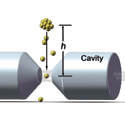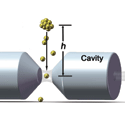Free falling
The technology for studying the interaction of an atom with a high-finesse optical cavity has reached such a high level of sensitivity that detecting quantum fields from a single photon and a single atom has become reasonably routine.
The same system can, in principle, track an atom’s trajectory: As the atom traverses the cavity, it disturbs the allowed optical modes in the cavity in a way that can be detected. So far, however, attempts to do this weren’t able to narrow down the atom’s path with high resolution.
Now, researchers in China have proposed and demonstrated a method to unambiguously determine the trajectory of an atom using a high-finesse cavity. In a Rapid Communication appearing in Physical Review A, Pengfei Zhang and colleagues at Shanxi University, China, describe experiments where they tracked an atom’s path with a spatial resolution of nanometers and in a measurement time of microseconds.
The group releases a small sample of laser-cooled atoms from a trap located several millimeters above the center of the cavity. They then detect the strong coupling between the falling atoms and a tilted cavity mode—a mode that breaks the spatial symmetry and is therefore sensitive to the details of an atom’s path.
Zhang et al. are also able to extract an independent measurement of the atom cloud’s temperature by averaging over many single-atom measurements. Their technique could ultimately be applied to optomechanical cooling and time-resolved single atom-cavity microscopy. – Frank Narducci





